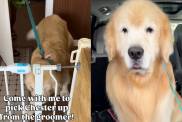When faced with a litter of adorable puppies, many of us think with our hearts, not our heads. We fall in love with the pup who has the fluffiest coat, or the biggest and most soulful eyes. But choosing the dog you’re going to live with for years to come based on looks alone makes as much sense as marrying someone because of his cute baby photo.
Take the time to find a pup who’s likely to fit what you want in a dog once she outgrows her prancing step and round belly. The first step is to figure out whether you’re truly ready for a dog. Then it’s time to find a good breeder. (Of course, adopting a homeless pup from a shelter or rescue group is another great option.)
Next, take the time to meet the puppies and feel out which one is likeliest to be your canine soul mate.
Behavior assessing a puppy
Behavior assessments (also known as temperament tests) are widely used by breeders and trainers to gauge what sort of personality a puppy will have when she grows up. However, there’s not much proof they really work that well. A puppy’s personality is hardly fixed, and a pup can respond differently to these tests from one week to the next.
Still, most experts think the tests offer at least some measure of whether a puppy is more or less likely to be timid or bold, clingy or independent as an adult.
Keep in mind that scoring one way or the other doesn’t mean a pup is doomed to turn into Cujo. What it may mean is that the puppy would do better in a different kind of home than you’re offering.
Some simple tests
1. Put the puppy on her back and cradle her in your lap, hand on her chest, looking in her eyes. If she struggles and tries to flip back over, she’s considered an independent pup; if she calmly submits, she’s considered less self-reliant and more likely to look for direction from you.
2. Pick her up by her front armpits, legs hanging down. If she struggles, that’s considered a sign of willfulness. A pup who submits is thought to be less headstrong.
3. Watch how the puppy reacts when a stranger (probably you) walks into the room. Kneel down, clap your hands, and speak to her encouragingly. Does she walk right up, tail high and wagging? If she ignores you, or retreats into a corner, she may end up being shy, reserved, or need lots of socialization to become friendlier.
4. Drop your keys, bang a pot, or clap loudly. How does the puppy react? A quick startle is normal, but watch to see how long it takes her to recover. If it takes a while, the puppy may grow up to be high-strung and scared of noise.
5. After playing with the pup for a bit, get up and walk away, making sure she sees you. Does she follow? Sit there watching you? Ignore you and move on to something else? Her response may signal how independent or clingy she’ll be as an adult.
6. Bring in a small animal in a cage–a cat, rabbit, or hamster, for instance. Your puppy’s reaction may signal how strong a prey drive she’ll have. A dog who gets really excited probably isn’t a good match for a home with other small critters. It also means you may not be able to let the dog off-leash when you’re walking outside.
7. Watch your puppy play with her littermates. Is she the one chasing, nipping, and forcing her littermates to roll over? Is she the one rolling over or tucking in her tail? Or is she somewhere in between? Most homes do best with a dog who’s somewhere between the leader of the pack and a shrinking violet.
8. Bring the whole family with you and watch how a puppy reacts to each member. If your pup is going to live with your energetic kids, or your tall husband with the booming voice, find out how she reacts to both prospects before bringing her home.
So which puppy is right for you?
You’ll need to do some thinking to answer this question. (First find out whether you’re Ready or not. Then meet your match with our MatchUp.)
1. What’s your training style?
You’ll need to determine what kind of dog parent you want to be. That is, will you be comfortable setting and enforcing rules, or would you rather be more relaxed, or permissive?
Bold pups, for instance, need someone who’s just as confident, can set rules and–kindly, but insistently–makes sure the dog follows those rules, every time.
Timid, sensitive pups need a soft touch. A puppy who falls to pieces around lots of activity and noise would probably do better with a quiet, older owner than a household full of young kids.
2. What do you want in a dog?
Do you like having a buddy who sticks to you like glue? Or do you work all day and need a dog who won’t melt down when you walk out the door? If it’s the former, you could probably handle a clingy pup; if it’s the latter, you want a more independent soul. (Our MatchUp can help you find dogs likely to be independent, among many other characteristics.)
Do you want to be able to walk your dog off-leash? If so, a pup who seems to have a high prey drive may not be the right pick because she’s likely to take off after anything small and furry that streaks past.
3. Are there problem puppies?
No matter what kind of home you’re offering, most experts advise against getting a puppy who’s extremely shy. Although your heart may go out to the pup who’s cowering in the corner, tail between her legs, a very timid pup is more likely to snap or bite out of fear as an adult. At the very least, extremely shy puppies need lots and lots of training to make them safe family pets.
Bringing your puppy home
Your puppy’s personality will continue to take shape after you bring her home, and you’ll play a big role in shaping it. To keep your pup on the right track, start housetraining right away, socialize your puppy to people and dogs, and sign up for puppy classes.
Bottom line: Behavior assessments are often used to gauge a puppy’s personality, but they’re an inexact science. In fact, they’ve never been conclusively proven to work. Still, they may help you make a more educated guess on which puppy is the best fit for you. Just keep in mind that how a pup fares on these tests at eight weeks isn’t an ironclad guarantee of who she’s likely to become.









